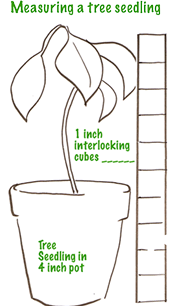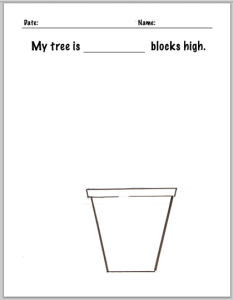Involve children in nature education and help them learn that the choices they make do change the world around them. Rather than overloading children with too many environmental problems focus their attention on actions they can take to help the Earth.
Teaching children to value clean water and care for trees will help them feel more connected to nature. Making clean water and growing tree seedlings, are two easy ways to involve children in nature education.
Make Clean Water
Most young children have not given too much thought to clean water. They turn on the tap and clean, ready to drink water comes out. Some are used to drinking water out of a water filter system.
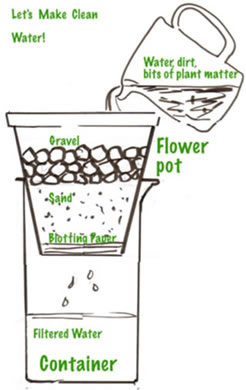
This nature education experiment shows children how dirty muddy water can be cleaned by filtering it through gravel and sand and shows them what goes on inside a water filtering system.
Materials:
- gravel
- sand
- blotting paper or 3 or 4 coffee filters
- clean flower pot
- transparent jug
- large measuring cup or pouring jug
Have small groups of children take turns making a water filter (or if necessary the class can sit in a circle and watch as you do it).
Procedure:
- Put blotting paper or 3 or 4 coffee filters, then sand, and finally gravel in a clean flower pot
- Place the flower pot in a larger transparent container so the filtered water can drip through and the children can observe it
- In a large measuring cup, place dirt, bits of plant matter and water
- Mix it up to make muddy water
- Pour the muddy water into the flower pot as shown in the image on the right
- Children observe the color of the water dripping out the bottom of the pot into the transparent container
- Ask questions – Where did the dirt go? Why did cleaner water come out?
- Take the filter apart and try to find the dirt and bits of plant matter

More: Try arranging the layers in a different order and compare the color of the filtered water.
Grow tree seedlings
Trees not only provide homes for animals, they affect the quality of the air we breathe.
- Take children on a walk around a park, neighbourhood or forest and look for tree seeds, such as acorns, horse chestnuts, maple seeds, or beechnuts.
- Have each child put some rocks in the bottom of a 3 or 4 inch pot, then put potting soil on top
- Each child plants 2 or 3 tree seeds and places the pots on a window sill or table near a window
- Have kids take turns watering once a week
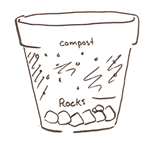
- Give them a coffee scoop and a cup of water to limit the amount of water (2 scoops per plant for example)
- Plant extras tree seeds and do not put name tags on the plants as the plants that sprout will be shared out in the Spring
After trees sprout:
- Give each child a tree seedling and label the pots with the children’s names
- Keep extra tree seedlings for experiments and in case some die
- Have children measure their tree’s growth with interlocking 1″ blocks once a week
- The children can put their results on a recording sheets such as the free download below and make a Nature Education booklet
- Once the tree seedlings reach 4 to 5 inches tall, they can be planted outside
- Brainstorm with the children the best places to plant the trees (not next to fences, roads or houses) and why
- Send the seedlings home with a note to parents or plant them in the school yard if possible
- Click on the recording sheet below to download it
Tree Seedling Experiment
This nature education activity uses one of the tree seedlings, a plastic bag and a string.
- Tie a plastic bag around a tree seedling and tie with a string
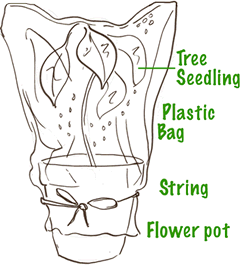
- Children make observations and ask them what they notice
- Let the tree in the bag sit in a warm and sunny place for a few days until water droplets form on the inside of the bag
- Have the children make observations again
- Ask a focus question, “Where did the water come from?”
- The water in the bag is coming from the leaves of the plant (a process called transpiration). The bottom of the leaf has lots of tiny holes in it (called stomata). Besides letting air get in and out, the holes let water get out. As water evaporates from the leaves, more water and nutrients are sucked up by the roots. The water goes out into the air and is part of the water cycle.
- Keep the explanation simple for young children and have them record their observations in a science booklet.
